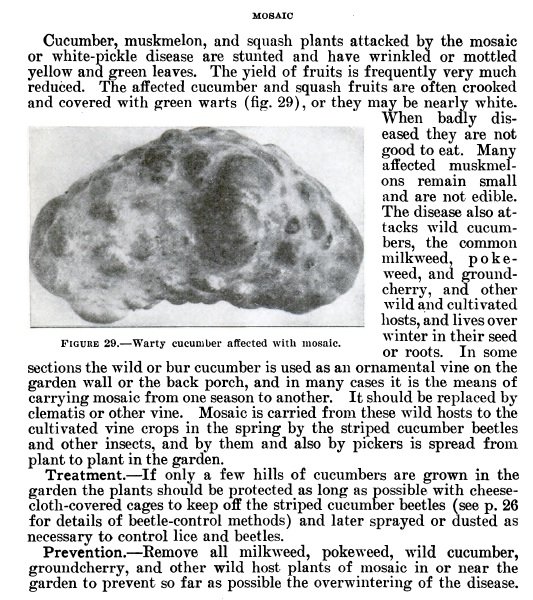Blight at the End of the Tunnel
Around 1919, Long Island's pickle industry saw its first hints of trouble. Here and there, blights, especially White-Pickle Disease (also called Mosaic), appeared in the great cucumber fields. Instead of green cucumbers, farmers' labors began to yield repulsive, white, inedible lumps.
"Diseases and Insects of Garden Vegetables"
USDA Farmer's Bulletin No. 1371, 1924
Googlebooks.com
In hindsight, it is easy to say - as could later be said also of potatoes - that in this era, growing many millions of bushels of produce, year after year, on densely farmed Long Island made epidemics of blight inevitable. In this case, the primary vectors for spreading the diseases were small (1/4" long), rather handsome yellow-and-black cucumber beetles, especially the striped and twelve-spotted species shown at the beginning of this article.
By August 1920, newspapers reported that cucumber and cabbage fields on

The Brooklyn Daily Eagle
With little or no usable harvest available, and a future that looked even worse, the Heinz complex had become unsustainable. After nearly thirty years, the Hicksville pickle works story ended as suddenly as it had begun. The local Heinz factory was far from the only pickle business casualty: competitors in Farmingdale, Greenport, and towns to the east all went the same way.

Huntington Long-Islander, June 23, 1922
Local farmers started to realize that Hicksville's agricultural heyday would not last forever; change was already coming, bit by bit. Some hoped to hang on as long as they could by planting different crops. Others reasoned that the best thing to do was to sell their land to developers, who would divide it into lots and build on it. A flurry of new construction began transforming the old farmland - more houses, more people, and soon a new High School on Jerusalem Avenue.
What about the shuttered pickle works? It facilitated the change. The site once selected by the townspeople because of its railroad access and proximity to farms would again prove convenient: it became a satellite location for the Brooklyn lumber supplier who provided the wood for building all those new houses.
***

